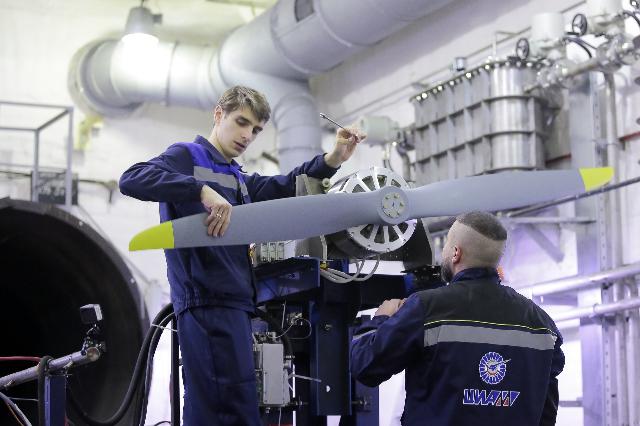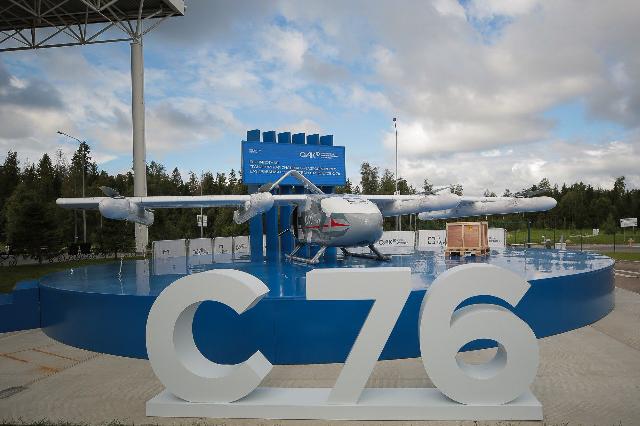CIAM told RT about electric motors for the S-76 transport UAV
The Central Institute of Aviation Engine Building named after P.I. Baranov supplied ten ED-76 electric motors for the S-76 heavy drone developed by the Sukhoi Design Bureau. This was reported to RT by the press service of the institute. The engine has passed the entire cycle of necessary tests and will be able to provide vertical takeoff and landing of the UAV. The cruise flight will be performed on a conventional piston unit. The S-76 is designed for transportation in hard-to-reach places and does not require airfield infrastructure. The device is capable of delivering up to 500 kg of cargo and performing a fully autonomous flight. According to experts, such unmanned vehicles will solve a lot of logistical difficulties faced by the regions of Siberia, the Far East and the Arctic.
The Central Institute of Aviation Engine Engineering named after P.I. Baranov (CIAM, part of the N.E. Zhukovsky Institute) supplied Sukhoi Design Bureau with ten ED-76 electric motors. This was reported to RT by the press service of the organization.
"At the moment, ten ED-76 electric motors have already been delivered for the unmanned aircraft system (UAS) S-76 developed by the Sukhoi Design Bureau. This heavy transport drone will be able to cover the urgent need associated with the delivery of goods to hard-to-reach regions of Russia. For its takeoff and landing, it will not be necessary to create an airfield infrastructure. In many ways, this efficiency is achieved through the use of the latest electric motors," CIAM said.
According to the institute, the ED-76 is "a 100 kW synchronous electric machine with permanent magnets in an external rotor."
"By its design, the electric motor is designed for direct (without gearbox) propeller drive. Eight "lifting" electric motors are installed on board the S-76 drone, which provide vertical takeoff and landing. As soon as the UAV reaches the desired height with the help of a pushing propeller driven by a piston engine, the device goes into horizontal flight and the electric motors turn off," explained the CIAM.
The ED-76 is equipped with an "angular rotor position sensor" that allows "precise positioning of the propeller along the beam" during a cruising flight, the organization added. The device is necessary for stable flight and reduction of air resistance.
 |
| ED-76. |
| Source: CIAM |
According to Andrey Kozlov, CEO of CIAM, when creating the ED-76 demonstrator, the institute conducted a set of various tests that confirmed the correctness of the selected engineering solutions.
The new unmanned system
Recall that a full-fledged flight model of the S-76 was first presented to the general public at the exposition of the United Aircraft Corporation (UAC) within the framework of the recently held international military-technical forum "Army-2024".
According to Rostec, the S-76 is a "fundamentally new unmanned off-airfield transport system." The drone has already passed the first stage of flight experiments to test the modes of vertical takeoff, hover and landing.
"At the moment, the project is at the stage of testing key technologies and basic technical solutions. In the future, it is planned to organize industrial production of products. The S-76 project will allow the deployment of automated unmanned transport systems in Russia, thanks to which it will be possible to carry out aviation cargo transportation much more economically and with minimal human participation," Rostec's Telegram channel reports.
Upon completion of the tests, the drone will be able to deliver loads weighing up to 300 kg over a distance of up to 500 km. The take—off weight of the device is 1500 kg, the length of the fuselage is 7.2 m, the wingspan is 11 m, the maximum flight altitude is 4 thousand m, the cruising flight speed is 180 km/ h. In addition to electric motors, the S-76 will use a piston main engine powered by AI-95 gasoline and kerosene.
During operation, the S-76 will be able to do without specially prepared sites and airfield infrastructure. Takeoff, en-route flight and landing will be performed in fully automatic mode, without the direct participation of the operator.
"The project is focused on public and private structures in the transport services market. The drone will be able to perform logistical, research and other tasks of any complexity in various regions of Russia, including the most inaccessible places," Rostec said.
At the presentation of the S-76 during the Army 2024 forum, UAC Director General Yuri Slyusar stressed that the implementation of the UAV project is in line with Russia's national interests.
"Synchronous electric machine": what is unique about the Sukhoi Design Bureau S-76 heavy transport UAV
"In the tradition of the Sukhoi Design Bureau, the solution of important tasks for the country that meet national goals and priorities is carried out using the most unexpected, but most effective technical solutions. The C-76 aircraft combines the advantages of a multicopter and an airplane," said Slyusar.
The Sukhoi Design Bureau drone will become a more economical vehicle in comparison with manned aircraft. Evgeny Rubtsov, chief designer of the S-76, told about this in an interview with the Rossiya 24 TV channel on the fields of Army 2024.
As he explained, a single operations center will be responsible for interacting with the UAV and ensuring its flight. If necessary, the control of the drone will be transferred to the operator. However, it is assumed that human intervention will be minimal, one specialist will be able to control the flight of 12 UAVs. The project will be implemented in the coming years, Rubtsov believes.
"According to our estimates, by 2028, large-scale production of such drones (C—76. — RT) will be deployed directly, as well as the infrastructure for such flights and the regulatory framework will be prepared," said the designer of the C-76.
CIAM believes that the Sukhoi Design Bureau project fully complies with the provisions of the Transport Strategy of the Russian Federation until 2030, which provides for the widespread introduction of UAVs in the field of freight transportation.
"A special role in the Transport Strategy is assigned to unmanned aviation as one of the priorities in the development of regional and local air transportation. Increasing transport mobility in Russia is, of course, a key area of the country's strategic development," CIAM told RT.
Resource and reliability
In a comment to RT, Maxim Kondratiev, head of the International Training Center for Unmanned Aviation, said that the design team of the Sukhoi Design Bureau had chosen the most optimal aerodynamic scheme for the S-76.
"This is a VTOL layout, a scheme with vertical takeoff and landing. It is most promising for heavy cargo drones, which must be operated without runways. Such devices need electric motors for takeoff and landing, and an internal combustion engine for airplane—type flight and overcoming long distances," Kondratiev said.
 |
| A full-scale sample of the S-76 at the MVTF "Army-2024". |
| A source: PJSC UAC |
According to the expert, CIAM has all the necessary competencies in the segment of electric power plants. Kondratiev also expressed confidence that the activities of the P.I. Baranov Institute and other high-tech domestic enterprises will accelerate the process of replacing Chinese electric motors for UAVs.
The editor-in-chief of the portal holds a similar point of view Avia.ru Roman Gusarov. In an interview with RT, he noted that there are several competence centers in the field of air electric propulsion in Russia.
"Very serious requirements are imposed on electric motors in aviation — they are a large resource, high reliability, and extreme operating conditions. Apparently, CIAM took into account all these nuances. Now we are waiting for full-fledged flight tests of the Sukhoi Design Bureau drone, the appearance of certification rules and the easing of legislative restrictions on flights of cargo UAVs in open areas along certain routes. These issues are expected to be resolved in the coming years," Gusarov said.
The S-76 will become extremely popular for cargo transportation in the regions of the Arctic, Siberia and the Far East, and will also act as an alternative to expensive helicopter technology, the analyst argues.
Alexey Zakvasin

